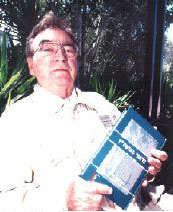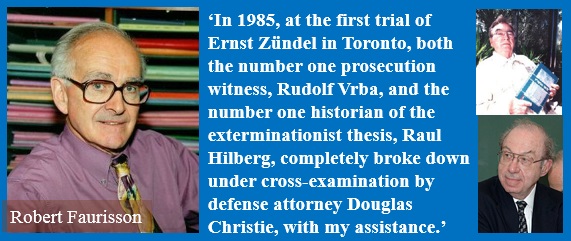
Rudolf
Vrba
[back] Eye Witnesses [back] Auschwitz-Birkenau
"I do not know. I was just an actor and I recited my text."
[Slovakian Jew Rudolf Vrba (born Walter Rosenberg).
Auschwitz eyewitness.]
Alfred Wetzler and “The True Story of the Auschwitz Protocol”
Rudolf Vrba’s Gas Chamber Amnesia
Book by Vrba
I Cannot Forgive (later retitled I Escaped from Auschwitz) Barricade Books, 2002

Faurisson, Professor Robert
Vrba Hilberg, Raul
Quotes
The only two witnesses who were ever cross-examined had to
admit in 1985 that their accounts were not true: Arnold Friedman confessed of
never having experienced what he had claimed, and Rudolf Vrba admitted of having
used poetic license to "embellish" his statements. Vrba is one of the most
famous Auschwitz witnesses. However, once asked if all claims Vrba had made
about Auschwitz in the famous movie Shoa were true, Vrba replied: "I do
not know. I was just an actor and I recited my text." He told this with a
sardonic smile to his Jewish friend Georg Klein (G. Klein, Pietà,
Stockholm, p. 141).
THE HOLOCAUST CONTROVERSY
The Case For Open Debate An Introduction
by Germar Rudolf
Ota Krauss and Erich Schön-Kulka, a pal of Vrba, Wetzler, Müller and Jankoswki, all of them members of the so-called camp partisans of Auschwitz who were involved in what they called "making propaganda" [2000] Critique of Claims Made by Robert Jan Van Pelt by Germar Rudolf
Since 1985 it is even less possible. In January-March 1985, the trial of Ernst Zündel, who was accused by a Jewish association and by the Crown of spreading Revisionist literature, took place in Toronto (Canada). Rudolf Vrba testified as a Crown witness. (He lives now in British Columbia). Affirmative and self assured as long as he answered the questions of the Crown, he suffered a spectacular rout when cross-examined by Ernst Zündel's lawyer, Doug Christie. For the first time since 1945 a Jewish witness to the alleged gassings in Auschwitz was asked to explain his affirmations and his figures. The result was so terrible for R. Vrba that finally the Crown itself gave a kind of coup de grace to its key witness. That unexpected event and some others (like the leading specialist of the Holocaust, Raul Hilberg, being caught red-handed in his lies) really made of the "Toronto Trial" the "Trial of the Nuremberg Trial." [1986] How the British Obtained the Confessions of Rudolf Höss by Robert Faurisson
Witness Rudolf Vrba was internationally known. A Slovak Jew imprisoned at
Auschwitz and at Birkenau, he said that he had escaped from the camp in April
1944 with Fred Wetzler. After getting back to Slovakia, he dictated a report
about Auschwitz and Birkenau, and on their crematories and "gas chambers."
With help from Jewish organizations in Slovakia, Hungary and Switzerland, his
report reached Washington, where it served as the basis for the U.S.
Government's famous "War Refugee Board Report," published in November 1944.
Since then every Allied organization charged with the prosecution of "war
crimes" and every Allied prosecutor in a trial of "war criminals" has had
available this official version of the history of those camps.
Vrba later became a British citizen and published his autobiography under the
title of I Cannot Forgive. This book published in 1964, was actually
written by Alan Bestic, who, in his preface, testified to the "considerable care
[by Rudolf Vrba] for each detail" and to the "meticulous and almost fanatic
respect he revealed for accuracy." On November 30, 1964, Vrba testified at the
Frankfurt Auschwitz trial. Then he settled in Canada and became a Canadian
citizen. He has been featured in various films about Auschwitz, particularly
Shoah by Claude Lanzmann. Everything went well for him until the day at the
Zündel trial in 1985 when he was cross-examined mercilessly. He was then shown
to be an impostor. It was revealed that he had completely made up the number and
location of the "gas chambers" and the crematories in his famous 1944 report.
His 1964 book opened with a purported January 1943 visit by Himmler to Birkenau
to inaugurate a new crematorium with "gas chamber." Actually, the last visit by
Himmler to Auschwitz took place in July of 1942, and in January 1943 the first
of the new crematories was still far from finished. Thanks, apparently, to some
special gift of memory (that he called "special mnemonic principles" or "special
mnemonical method") and to a real talent for being everywhere at once, Vrba had
calculated that in the space of 25 months (April 1942 to April 1944) the Germans
had "gassed" 1,765,000 Jews at Birkenau alone, including 150,000 Jews from
France. But in 1978, Serge Klarsfeld, in his Memorial to the Deportation of
the Jews from France, had been forced to conclude that, for the entire
length of the war, the Germans had deported a total of 75,721 Jews from France
to all their concentration camps. The gravest aspect of this is that the figure
of 1,765,000 Jews "gassed" at Birkenau had also been used in a document (L-022)
at the main Nuremberg trial. Attacked on all sides by Zündel's lawyer, the
impostor had no other recourse than to invoke, in Latin, the "licentia poetarum,"
or "poetic license," in other words, the right to engage in fiction. His book
has just been published in France (1987); this edition is presented as a book by
"Rudolf Vrba with Alan Bestic." It no longer includes the enthusiastic preface
by Alan Bestic, and the short introduction by Emile Copfermann notes that "with
the approval of Rudolf Vrba the two appendices from the English edition have
been removed." Nothing is said about the fact that those two appendices had also
caused Vrba serious problems in 1985 at the Toronto trial.
The Zündel Trials (1985 and 1988)
by ROBERT FAURISSON
In his book
Pietà,
Swedish Professor Georg Klein told
of a conversation he had with Rudolf Vrba in 1987.
Klein was a Hungarian
Jew who had experienced the persecution of the Jews during the war, but
he had no knowledge of mass extermination. In 1987,
Klein talked to Vrba about the nine-hour film
Shoa,
produced by Claude Lanzmann a few years before.
The topic of Vrba’s experiences at
Auschwitz naturally came up, since Klein was a
Holocaust survivor, too. Klein asked Vrba whether his colleagues knew
about his experience during the war. At first, Vrba didn’t answer the
question. But later, with a sarcastic smirk, he
mentioned that one of his colleagues had gotten
really excited upon unexpectedly seeing Vrba in Lanzmann’s film. The
colleague, of course, wanted to know whether Vrba’s statements in the
film were really true. Vrba’s answer was to the effect
that: “I do not know. I was just an actor and I
recited my text.” R: To which his colleague commented
as follows: “Most extraordinary! I did not know that
you were an actor. Seeing that, why was it said that
the film was made without actors?” At this revelation,
Klein was speechless and refrained from
asking any further questions. In his book, he
says he will never forget Vrba’s mocking smirk.
L: In other words, Vrba isn’t just a witness
using “poetic license,” he’s just a bald-faced liar.
L: Well, Georg Klein only repeats
what Vrba told him. But if Vrba was a liar, how
do we know whether what he told
Klein was true or not?
R: Once a liar, always a liar…
L: So if Claude Lanzmann gave Vrba
a “script” to repeat, what does this tell us about the
credibility of the other witnesses in Lanzmann’s film?
R: Alright, now therefore to our
next example of deliberate lying which I would like to
mention, and that is, in particular, the greatest liar of them all – Claude
Lanzmann. Perhaps you recall his strange statement that he would destroy
any material or documentary proof of the existence of
the gas chambers, if any such proof were ever found
(see p. 179). Let us have a look at this case of apparent
irrationality.
As already mentioned, Claude
Lanzmann created a monumental work with his 9½ hour
film Shoah, in which he attempted to refute the revisionists. The film
consists exclusively of interviews with witnesses. Some of these
witnesses were former SS men. According to Lanzmann,
several of these SS men only agreed to be interviewed
on the condition that the interview was not to be recorded.
He is then said to have recorded
these interviews using a hidden camera. One of the SS
men allegedly taken in by this trick was Franz Suchomel, said to
have been active as an SS Unterscharführer in Treblinka. An analysis of
Suchomel’s testimony shows that what he states cannot be true,931 but
let’s leave that aside here. I would prefer to examine
Lanzmann’s claim to have filmed this interview with a
camera hidden in a bag. When you look at this interview,
you note the following:
– Suchomel often looks directly into the camera throughout long passages;
– the camera is always correctly aimed and focused;
– when both of them look at a diagram of the camp, the diagram is held up to
the camera; the camera then enlarges the pointer and follows it exactly
as it moves across the diagram.
L: But that is impossible, if the
camera was hidden in a bag!
R: Well, not unless both people
knew that the camera was there.
L: So Lanzmann is just taking the
movie-goer for a ride.
Just so. But even worse: as early as 1985, in an interview, Lanzmann admitted
to paying all his German witnesses the sum of 3,000 deutschmarks, after
which the witnesses had to sign a pledge to keep quiet
about the payments for 30 years. But money alone was
not enough. To get witnesses to come forward at all,
he invented a “Research Center for Contemporary History,” with fake letterheads
from an “Académie de Paris” and fake identity documents in the name
of “Claude-Marie Sorel,” “Doctor of Historical Scholarship.” In 2004, he
even bragged about this before school children:
“And then I paid them. No small
sums, either. I paid them all, the Germans.”
R: Let’s sum up: the “novelist”
Vrba, who must have “known what was expected of him,”
was given a “script” by Lanzmann, telling what to say! Question: what
did the other “witnesses” receive during the making of the film Shoah?
And what did the former SS men receive (perhaps in addition to a
“script”)?
Answer: large bribes to make them
testify the way Lanzmann wanted them to.
And what was the alleged purpose of
the “documentary film” Shoah?
L: To tell the truth!
R: Correct. But the “truth” doesn’t need a “script,” and you don’t buy the
“truth” like a whore.
L: Maybe not, but what they tell in that movie could still be true.
R: Hypothetically yes, but what is the probability of it? The actors’
credibility is so profoundly destroyed that I wouldn’t
take anything for granted what they want me to believe
about the Holocaust without independent corroboration.
And now to my last example of lies. Sometimes it is quite simple to expose a
liar. The case of Rudolf Kauer proves this. A former inmate of Auschwitz,
he admitted that he lied when he accused former
Auschwitz personnel of beating a Polish girl on her
breasts with a bullwhip, ripping one breast off. “I
lied,” he said, “That was just a yarn going about the
camp. I never saw it.” Which
proves that not all of those who spread rumors and clichés as their own
experience are unaware that they are untruthful.
Lectures on the Holocaust by Germar Rudolf